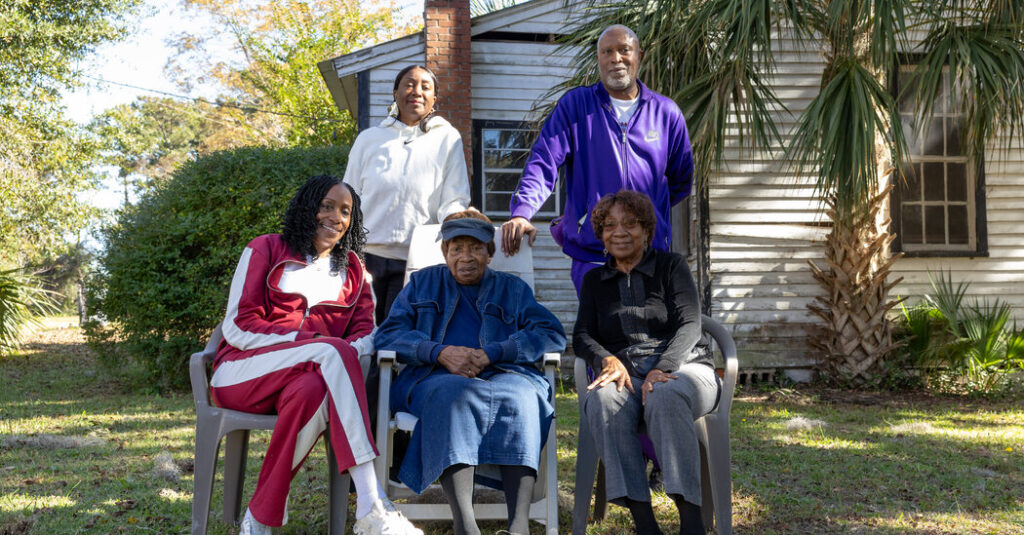Winston Johnson was worried about the future of his family’s land.
More than a century ago, his great-grandfather purchased a hundred-acre parcel in Beaufort County, S.C. Encircled by tidal creeks and salt marshes, it was called Halfmoon Island. Mr. Johnson and his siblings spent their childhood summers there. They would arrive on an Amtrak train from their home in New York City, trading concrete and lights for fields, forests and stars.
Over the decades, the property had always been passed down informally from one generation to the next. But as the family grew, it became unclear exactly who had a stake in it. Mr. Johnson had heard stories of families losing land because of tax delinquency or an outsider with a claim forcing a sale.
50 States, 50 Fixes is a series about local solutions to environmental problems. A few more to come this year.
“We wanted to find a way to protect the property,” Mr. Johnson said. “We wanted to continually pass it down to future generations.”
By realizing those aspirations, heirs like Mr. Johnson can preserve their family’s legacy and build generational wealth. And often, there is an added bonus: They are conserving the land at the same time.
Across the country — notably in the rural South, Appalachia and parts of the West — hundreds of thousands of properties are estimated to have an unclear title, which makes them vulnerable to loss. Known as heirs’ property, the land in question sometimes represents a family’s only economic inheritance.
Conservation on private property is a success story in South Carolina, but it has long been the purview of the wealthy, sometimes on former plantations. For people with fewer resources, taking care of the land is harder. The state is one of the fastest-growing in the country and development pressure is acute. When family land is sold, the result is often more coastal development and gated communities.
Now, a growing effort seeks to help at-risk landowners hold on to their property and leverage it sustainably, making some money and helping the environment all at once.
“Part of what we need to do in the conservation community is expand what we call conservation,” said J. Drew Lanham, an ornithologist and professor of wildlife ecology at Clemson University.
“The first step is owning that land, having clear title to it, and then being able to make informed decisions about how we can serve nature and nature can serve us,” Dr. Lanham said. “It’s a sort of exchange.”
Halfmoon Island is an example of the possibilities in play. According to family history, Mr. Johnson’s great-grandfather, a veteran of the Union Army, purchased the property for $500 in the early 1900s.
His son, Mr. Johnson’s grandfather, went on to raise farm animals and grow vegetables there.
During summers at Halfmoon Island, Mr. Johnson remembers crabbing in the creeks and tickling the hogs’ bellies to get them to flop over. His sister Debra Wallace recalls feasting on fruit right off the branch and vine.
“It was just the best place to be,” Ms. Wallace said.
The family is Gullah Geechee, a group that descends from enslaved West Africans forced to work rice and cotton plantations on the southeastern coast. Heirs’ property issues and rising taxes have cost many Gullah families their land, including on the affluent Hilton Head Island.
In Mr. Johnson’s quest to untangle Halfmoon Island’s title, he took to the internet and came across the Center for Heirs’ Property, a nonprofit group with a mission to help families keep their land and build generational wealth.
At first, the center had focused only on legal issues, but in 2013, it added a sustainable forestry program to help families generate income from their land without selling it.
“We’re basically a social service organization that happens to use law and forestry as the tools that help our families,” said Jennie Stephens, the center’s chief executive.
Now the organization has eight foresters on staff who have helped guide about 700 families that collectively manage 40,000 acres or so. They often recommend planting longleaf pine, a tree that was once widespread across the Southeast but has suffered drastic declines. The species requires regular fire, and the foresters teach clients about the importance of prescribed burns.
Families can restore an ecosystem that supports native wildlife like bobwhite quail, red-cockaded woodpeckers and gopher tortoises, while also growing and selling timber.
“At least they need to make enough to pay their taxes so they don’t lose it in tax sale,” said Steve Patterson, the center’s director of forestry services, referring to family land.
It took several years for Mr. Johnson and his family to resolve the title for Halfmoon Island. In the end, 22 family members were found to hold a share. Now the family is exploring the next steps. Certain members want to put the land into a conservation easement, which offers payment or tax breaks in exchange for permanently prohibiting development. Others would prefer to steward the land while keeping their options open.
In the meantime, they are addressing coastal erosion and plan to start restoring the forest. Having clear title to the land opens up access to financial support from the government and nonprofit groups that would not have been available before.
“I just envision myself walking in the forest, walking between the trees,” Mr. Johnson said. “Freedom comes to my mind.”
Catrin Einhorn covers biodiversity, climate and the environment for The Times.
The post ‘Freedom Comes to My Mind’: Saving Family Legacy and Land in South Carolina appeared first on New York Times.




